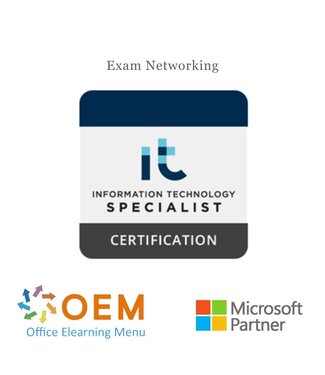Examen Networking
Kandidaten voor dit examen moeten basiskennis en -vaardigheden aantonen op het gebied van netwerken, waaronder TCP/IP, netwerkservices, netwerktopologieën en probleemoplossing in bedrade en draadloze omgevingen.
Kandidaten voor dit examen zijn bekend met algemene netwerkconcepten en -technologieën
en begrijpen hoe ze een netwerk in een klein-middelgroot bedrijf moeten beheren en problemen moeten oplossen omgeving. Kandidaten moeten enige praktische ervaring hebben met Windows en Linux
besturingssystemen, TCP/IP, naamomzettingsprocessen, netwerkservices en netwerk topologieën en probleemoplossing in bedrade en draadloze omgevingen. Kandidaten moeten ten minste 150 uur instructie of praktische ervaring met netwerken hebben.
To be successful on the test, the candidate is also expected to have the following prerequisite knowledge and skills:
- 8th grade reading skills
- Basic operating system skills
- Problem-solving and critical thinking skills
- Basic hardware/software skills
- Digital literacy skills, including the ability to research, create content, and solve
problems using technology
1. Networking Fundamentals
1.1 Define network concepts
- Internet, intranet, extranet, client-server, peer-to-peer, transmission types (unicast, multicast, broadcast), network devices including IoT
1.2 Define cloud and virtualization concepts
- Hypervisors, virtual machines, virtual switches
1.3 Describe remote access methods
- Virtual Private Network (VPN), Remote Desktop
2. Network Infrastructures
2.1 Define the characteristics of local area networks (LANs)
- Perimeter networks (security zones, DMZ), VLANs, wired LAN and wireless LAN
2.2 Define the characteristics of wide area networks (WANs)
- DSL, site-to-site, cable modem, satellite, cellular (3G, 4G, 5G)
2.3 Identify wireless networking methods and characteristics
- Types of wireless networking standards and their characteristics (802.11, Bluetooth), types of network security (WPA, WPA2, WEP, 802.1X, and others), point-to-point (P2P) wireless, ad hoc networks, wireless bridging, wireless interference
2.4 Compare and contrast network topologies and access methods
- Star, mesh, ring, bus, logical and physical topologie
3. Network Hardware
3.1 Describe characteristics of switches
- Number and type of Ethernet ports (access vs. trunk), number of devices supported, managed or unmanaged switches, VLAN capabilities, Layer 2 and Layer 3 switches and security options, potential for single point of failure, switching types and MAC table, capabilities of hubs vs. switches
(collision domain, broadcast domain, half- and full-duplex), prevention of switch loops by using spanning tree protocol
3.2 Describe characteristics of routers
- Potential for network bottlenecks, directly connected routes, static routing, dynamic routing (routing protocols), default routes, routing table and how it selects best route(s), port forwarding, Quality of Service (QoS), network segmentation, convergence
3.3 Describe characteristics of physical media
- Cable types and their characteristics, including media segment length and speed; fiber optic, twisted pair shielded or unshielded (CAT5–CAT7 cabling); configuration (crossover vs. straight-through); susceptibility to electromagnetic interference (EMI), cross-talk, and interception
4. Protocols and Services
4.1 Describe the Open Systems Interconnection (OSI) model
- Identification and purpose of each layer; examples of devices, protocols, and applications at each layer; MAC address
4.2 Describe the Transmission Control Protocol (TCP) model
- Identification and purpose of each layer; examples of devices, protocols, and applications at each layer
4.3 Describe IPv4 concepts
- Classful vs. classless addressing, subnetting (purpose and why to use), characteristics of IPv4 addressing (subnet mask, default gateway, sockets, broadcast), private addresses (Class A (including loopback), Class B, and Class C)
4.4 Describe IPv6 concepts
- Characteristics of IPv6 addressing (subnet mask, default gateway, sockets, abbreviation), transitioning from IPv4 to IPv6 (tunneling protocols, tunnel brokers, dual IP stack), address types (link-local vs. global), multicast groups (all routers/all nodes), loopback
4.5 Identify well-known ports
- HTTP, HTTPS, FTP, SMTP, IMAP, DNS, RDP, SSH
4.6 Describe name resolution concepts
- Static name resolution (HOSTS file, LMHOSTS file), dynamic name resolution (DNS, WINS), DNS resource records (A, AAAA, MX, PTR, SRV, CNAME, SOA), forward vs. reverse lookups, steps in the name resolution process
4.7 Identify the roles of networking services
- Dynamic Host Configuration Protocol (DHCP), Network Address Translation (NAT) (dynamic vs. static, public vs. private, port address translation), firewalls
5. Troubleshooting
5.1 Given a scenario, describe the troubleshooting process in a smallmedium business network
- Steps in the troubleshooting process, etiquette/professional conduct
5.2 Given a scenario, use the appropriate hardware troubleshooting tools
- Appropriate tool selection, multimeter, cable tester, toner, time-domain reflectometer (TDR), optical TDR (OTDR)
5.3 Given a scenario, use the appropriate Windows software tools to troubleshoot a problem
- Appropriate tool selection, syntax (ping, ipconfig, tracert, pathping, nslookup, hostname, netstat, arp), local loopback IP, protocols
5.4 Given a scenario, use the appropriate Linux software tools to troubleshoot a problem
- Appropriate tool selection, syntax (ping, ip addr, traceroute, tracepath, dig, host, netstat, arp)


